Impacts of Extreme Weather Event in Southeast Brazilian Mangrove Forest
Abstract
1. Introduction
2. Materials and Methods
2.1. Study Area
2.2. Multiproxy Approach
2.3. Climate
2.4. Mangrove Structural Vegetation
2.5. Remote Sensing
3. Results
3.1. Climate
Synoptic Conditions for the Period of 28–30 May 2019
3.2. Mangrove Structural Vegetation
3.3. Remote Sensing
4. Discussion
5. Conclusions
Author Contributions
Funding
Institutional Review Board Statement
Informed Consent Statement
Data Availability Statement
Acknowledgments
Conflicts of Interest
References
- Goldberg, L.; Lagomasino, D.; Thomas, N.; Fatoyinbo, T. Global declines in human-driven mangrove loss. Glob. Chang. Biol. 2020, 26, 5844–5855. [Google Scholar] [CrossRef] [PubMed]
- Jahfer, S.; Vinayachandran, P.N.; Nanjundiah, R.S. Long-term impact of Amazon River runoff on northern hemispheric climate. Sci. Rep. 2017, 7, 10989. [Google Scholar] [CrossRef] [PubMed]
- Friess, D.A.; Rogers, K.; Lovelock, C.E.; Krauss, K.W.; Hamilton, S.E.; Lee, S.Y.; Lucas, R.; Primavera, J.; Rajkaran, A.; Shi, S. The State of the World’s Mangrove Forests: Past, Present, and Future. Annu. Rev. Environ. Resour. 2019, 44, 89–115. [Google Scholar] [CrossRef]
- Lovelock, C.E.; Cahoon, D.R.; Friess, D.A.; Guntenspergen, G.R.; Krauss, K.W.; Reef, R.; Rogers, K.; Saunders, M.L.; Sidik, F.; Swales, A.; et al. The vulnerability of Indo-Pacific mangrove forests to sea-level rise. Nature 2015, 526, 559–563. [Google Scholar] [CrossRef] [PubMed]
- Duke, N.C.; Kovacs, J.M.; Griffiths, A.D.; Preece, L.; Hill, D.J.E.; van Oosterzee, P.; Mackenzie, J.; Morning, H.S.; Burrows, D. Large-scale dieback of mangroves in Australia’s Gulf of Carpentaria: A severe ecosystem response, coincidental with an unusually extreme weather event. Mar. Freshw. Res. 2017, 68, 1816–1829. [Google Scholar] [CrossRef]
- Gomes, L.E.d.O.; Sanders, C.J.; Nobrega, G.N.; Vescovi, L.C.; Queiroz, H.M.; Kauffman, J.B.; Ferreira, T.O.; Bernardino, A.F. Ecosystem carbon losses following a climate-induced mangrove mortality in Brazil. J. Environ. Manag. 2021, 297, 113381. [Google Scholar] [CrossRef]
- McKee, K.; Rogers, K.; Saintilan, N. Response of Salt Marsh and Mangrove Wetlands to Changes in Atmospheric CO2, Climate, and Sea Level. In Global Change and the Function and Distribution of Wetlands; Global Change Ecology and Wetlands; Springer: Dordrecht, The Netherlands, 2012; pp. 63–96. [Google Scholar] [CrossRef]
- Ellison, J.C.; Zouh, I. Vulnerability to Climate Change of Mangroves: Assessment from Cameroon, Central Africa. Biology 2012, 1, 617–638. [Google Scholar] [CrossRef]
- Osland, M.J.; Day, R.H.; From, A.S.; McCoy, M.L.; McLeod, J.L.; Kelleway, J.J. Life stage influences the resistance and resilience of black mangrove forests to winter climate extremes. Ecosphere 2015, 6, art160. [Google Scholar] [CrossRef]
- Ward, R.D.; Friess, D.A.; Day, R.H.; MacKenzie, R.A. Impacts of climate change on mangrove ecosystems: A region by region overview. Ecosyst. Health Sustain. 2016, 2, e01211. [Google Scholar] [CrossRef]
- Duke, N.C.; Meynecke, J.-O.; Dittmann, S.; Ellison, A.M.; Anger, K.; Berger, U.; Cannicci, S.; Diele, K.; Ewel, K.C.; Field, C.D.; et al. A World Without Mangroves. Science 2007, 317, 41–42. [Google Scholar] [CrossRef]
- Friess, D.A.; Yando, E.S.; Alemu, J.B.; Wong, L.W.; Soto, S.D.; Bhatia, N. Ecosystem services and disservices of mangrove forests and salt marshes. Oceanogr. Mar. Biol. Annu. Rev. 2020, 58, 107–142. [Google Scholar]
- Duke, N. Gap creation and regenerative processes driving diversity and structure of mangrove ecosystems. Wetl. Ecol. Manag. 2001, 9, 267–279. [Google Scholar] [CrossRef]
- Sandilyan, S.; Kathiresan, K. Mangrove conservation: A global perspective. Biodivers. Conserv. 2012, 21, 3523–3542. [Google Scholar] [CrossRef]
- McIvor, A.L.; Spencer, T.; Möller, I.; Spalding, M. Storm Surge Reduction by Mangroves; NCP Report 2012-02; The Nature Conservancy and Wetlands International: Wageningen, The Netherlands, 2012. [Google Scholar]
- Das, S.; Crépin, A.-S. Mangroves can provide protection against wind damage during storms. Estuar. Coast. Shelf Sci. 2013, 134, 98–107. [Google Scholar] [CrossRef]
- Marois, D.E.; Mitsch, W.J. Coastal protection from tsunamis and cyclones provided by mangrove wetlands—A review. Int. J. Biodivers. Sci. Ecosyst. Serv. Manag. 2015, 11, 71–83. [Google Scholar] [CrossRef]
- Villamayor, B.M.R.; Rollon, R.N.; Samson, M.S.; Albano, G.M.G.; Primavera, J.H. Impact of Haiyan on Philippine mangroves: Implications to the fate of the widespread monospecific Rhizophora plantations against strong typhoons. Ocean Coast. Manag. 2016, 132, 1–14. [Google Scholar] [CrossRef]
- Osland, M.J.; Feher, L.C.; Griffith, K.T.; Cavanaugh, K.C.; Enwright, N.M.; Day, R.H.; Stagg, C.L.; Krauss, K.W.; Howard, R.J.; Grace, J.B.; et al. Climatic controls on the global distribution, abundance, and species richness of mangrove forests. Ecol. Monogr. 2017, 87, 341–359. [Google Scholar] [CrossRef]
- Sippo, J.Z.; Lovelock, C.E.; Santos, I.R.; Sanders, C.J.; Maher, D.T. Mangrove mortality in a changing climate: An overview. Estuar. Coast. Shelf Sci. 2018, 215, 241–249. [Google Scholar] [CrossRef]
- Duke, N.C.; Field, C.; MacKenzie, J.R.; Meynecke, J.-O.; Wood, A.L. Rainfall and its possible hysteresis effect on the proportional cover of tropical tidal-wetland mangroves and saltmarsh–saltpans. Mar. Freshw. Res. 2019, 70, 1047. [Google Scholar] [CrossRef]
- Abhik, S.; Hope, P.; Hendon, H.H.; Hutley, L.B.; Johnson, S.; Drosdowsky, W.; Brown, J.R.; Duke, N.C. Influence of the 2015–2016 El Niño on the record-breaking mangrove dieback along northern Australia coast. Sci. Rep. 2021, 11, 20411. [Google Scholar] [CrossRef]
- Ramsar. Sites Information Service. 2017. Available online: https://www.ramsar.org/wetland/brazil (accessed on 19 April 2023).
- Vasquez, M.O.; Cunha-Lignon, M. Mangrove monitoring using a multi-temporal analysis of satellite imagery on the Cana-néia-Iguape Coastal System (BRAZIL). In SEMANGLARES IV: Curso? Seminario Nacional de Estuarios y Manglares, Eco-Sistemas de Manglar Para el Bienestar Humano en un Entorno Cambiante; Boletín del Postgrado en Ciencias-Biología; Universidad Nacional de Colombia: Bogotá, Colombia, 2021; Volume 9, p. 51. [Google Scholar]
- De Mahiques, M.M.; Burone, L.; Figueira, R.C.L.; Lavenére-Wanderley, A.A.d.O.; Capellari, B.; Rogacheski, C.E.; Barroso, C.P.; dos Santos, L.A.S.; Cordero, L.M.; Cussioli, M.C. Anthropogenic influences in a lagoonal environment: A multiproxy approach at the valo grande mouth, Cananéia-Iguape system (SE Brazil). Braz. J. Oceanogr. 2009, 57, 325–337. [Google Scholar] [CrossRef]
- Cunha-Lignon, M.; Kampel, M.; Menghini, R.P.; Schaeffer-Novelly, Y.; Cintrón, G.; Dahdouh-Guebas, F. Mangrove Forests Submitted to Depositional Processes and Salinity Variation Investigated using satellite images and vegetation structure surveys. J. Coast. Res. 2011, I, 344–348. [Google Scholar]
- Lima, N.G.B.; Galvani, E. Interaction of climatic attributes in the mangroves of the south coast of São Paulo and their relation with climatic controls. CONFINS 2018, 1, 1–23. [Google Scholar]
- De Lima, N.G.B.; Cunha-Lignon, M.; Galvani, E. Microclimatic analysis of mangroves in two distinct categories of Protected Areas and conserved status. Soc. Nat. 2021, 33, 1–16. [Google Scholar] [CrossRef]
- Schaeffer-Novelli, Y.; Vale, C.C.; Cintrón, G. Monitoramento do Ecossistema Manguezal: Estrutura e características funcionais. In Protocolos de Campo para o Monitoramento de Habitats Bentônicos Costeiros. Rede de Monitoramento de Habitats Bentônicos Costeiros—ReBentos; Turra, A., Dedanai, M.R., Eds.; IOUSP: São Paulo, Brazil, 2015; pp. 65–83. [Google Scholar] [CrossRef]
- Deering, D.W. Measuring “forage production” of grazing units from Landsat MSS data. In Proceedings of the 10th International Symposium on Remote Sensing of Environment, Ann Arbor, MI, USA, 6 October 1975; Volume 2, pp. 1169–1178. [Google Scholar]
- Rondeaux, G.; Steven, M.; Baret, F. Optimization of soil-adjusted vegetation indices. Remote Sens. Environ. 1996, 55, 95–107. [Google Scholar] [CrossRef]
- Allen, R.G.; Tasumi, M.; Trezza, R. SEBAL (Surface Energy Balance Algorithms for Land) Advanced Training and Users Manual—Idaho Implementation; Idaho University: Moscow, ID, USA, 2002; 98p. [Google Scholar]
- Instituto Nacional de Meteorologia—INMET. It Presents Weather Forecast Data and Climate Studies of Brazil. Available online: https://portal.inmet.gov.br (accessed on 10 December 2019).
- Centro de Previsão de Tempo e Estudos Climáticos—CPTEC/INPE. It Presents Weather Forecast Data and Climate Studies of Brazil. Available online: http://www.cptec.inpe.br (accessed on 22 December 2020).
- De Lima, N.G.B.; Galvani, E.; Falcão, R.M.; Cunha-Lignon, M. Air temperature and canopy cover of impacted and conserved mangrove ecosystems: A study of a subtropical estuary in Brazil. J. Coast. Res. 2013, 165, 1152–1157. [Google Scholar] [CrossRef]
- Smith, T.J., III; Roblee, M.B.; Wanless, H.R.; Doyle, T.W. Mangroves, hurricanes, and lightning strikes. BioScience 1994, 44, 256–262. [Google Scholar] [CrossRef]
- Cunha-Lignon, M.; Almeida, R.; Lima, N.G.B.; Galvani, E.; Menghini, R.P.; Coelho, C., Jr.; Schaeffer-Novelli, Y. Monitoramento de manguezais: Abordagem integrada frente às alterações ambientais. Anais. In Proceedings of theVIII Congresso Brasileiro de Unidades de Conservação—Fundação Grupo Boticário—Trabalhos Técnicos, Curitiba, Brazil, 21–25 September 2015; pp. 1–17. Available online: https://eventos.fundacaogrupoboticario.org.br/VIIICBUC (accessed on 1 June 2023).
- Cunha-Lignon, M.; Lima, N.G.B. Health Status of the Mangrove Forest on the Southeastern Coast of the State of São Paulo (Brazil): From the Bottom (Soil Salinity and Vegetation Biomass) to Upwards (Canopy). In Book of Abstracts—VLIZ Marine Science Day; Vlaams Instituut voor de Zee—Flanders Marine Institute (VLIZ): Oostende, Belgium, 2021; Volume 85, pp. 40–41. [Google Scholar]
- Castañeda-Moya, E.; Lagomasino, D.; Kominoski, J.; Troxler, T.; Sah, J. Effects of hurricane Irma on mangrove forest structure in the florida everglades, USA. Investigatio 2022, 17, 121–123. [Google Scholar]
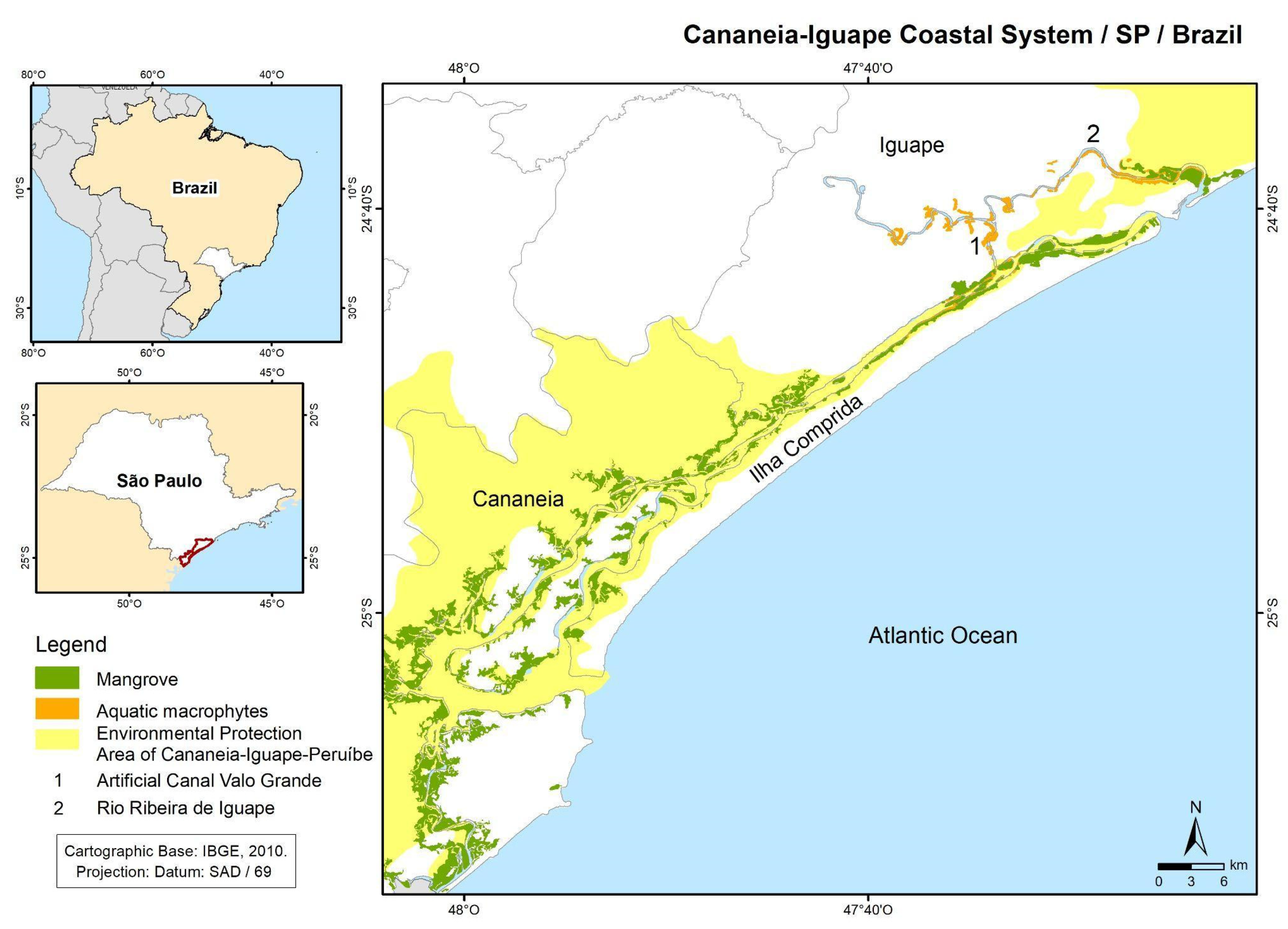
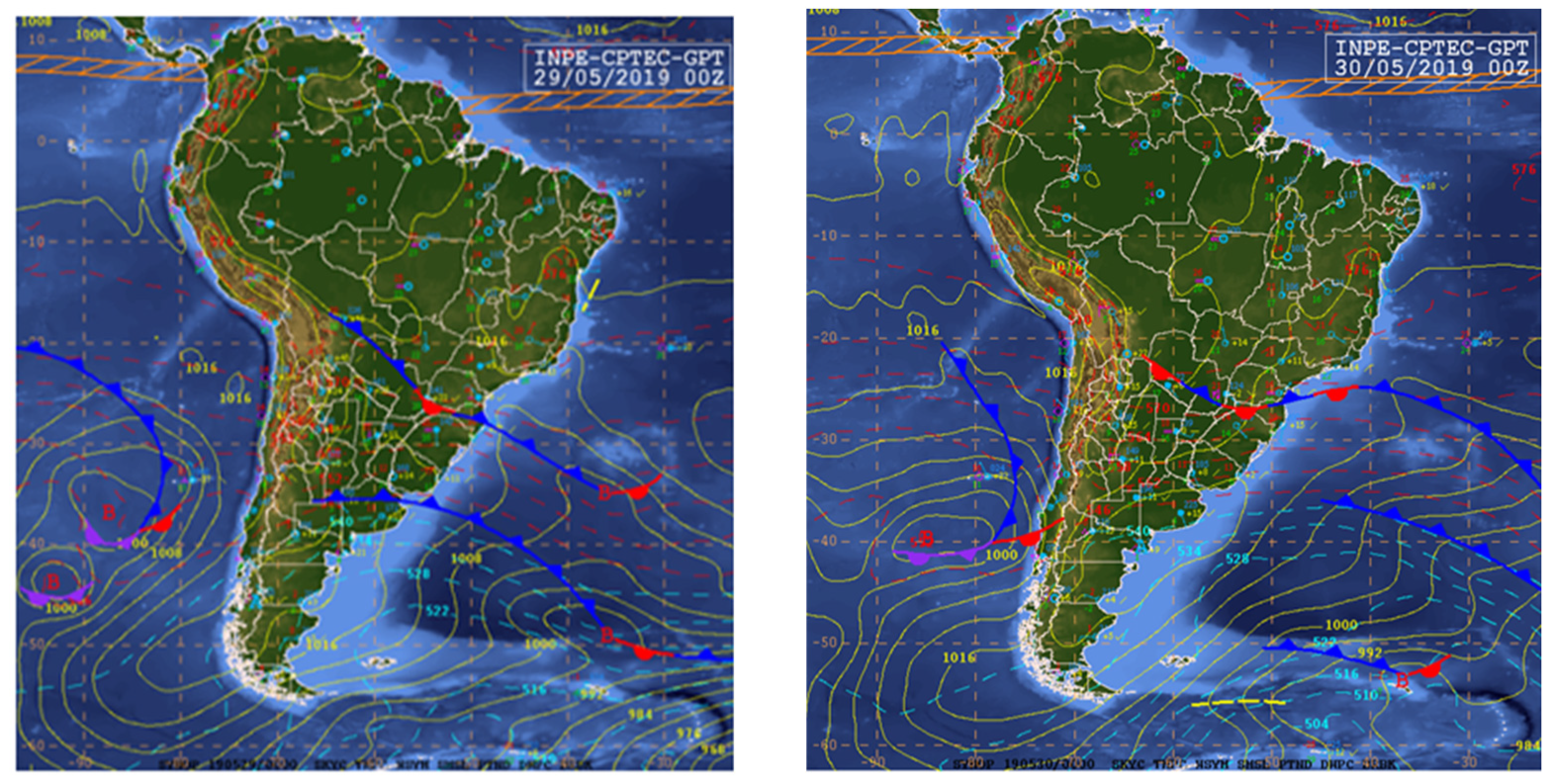

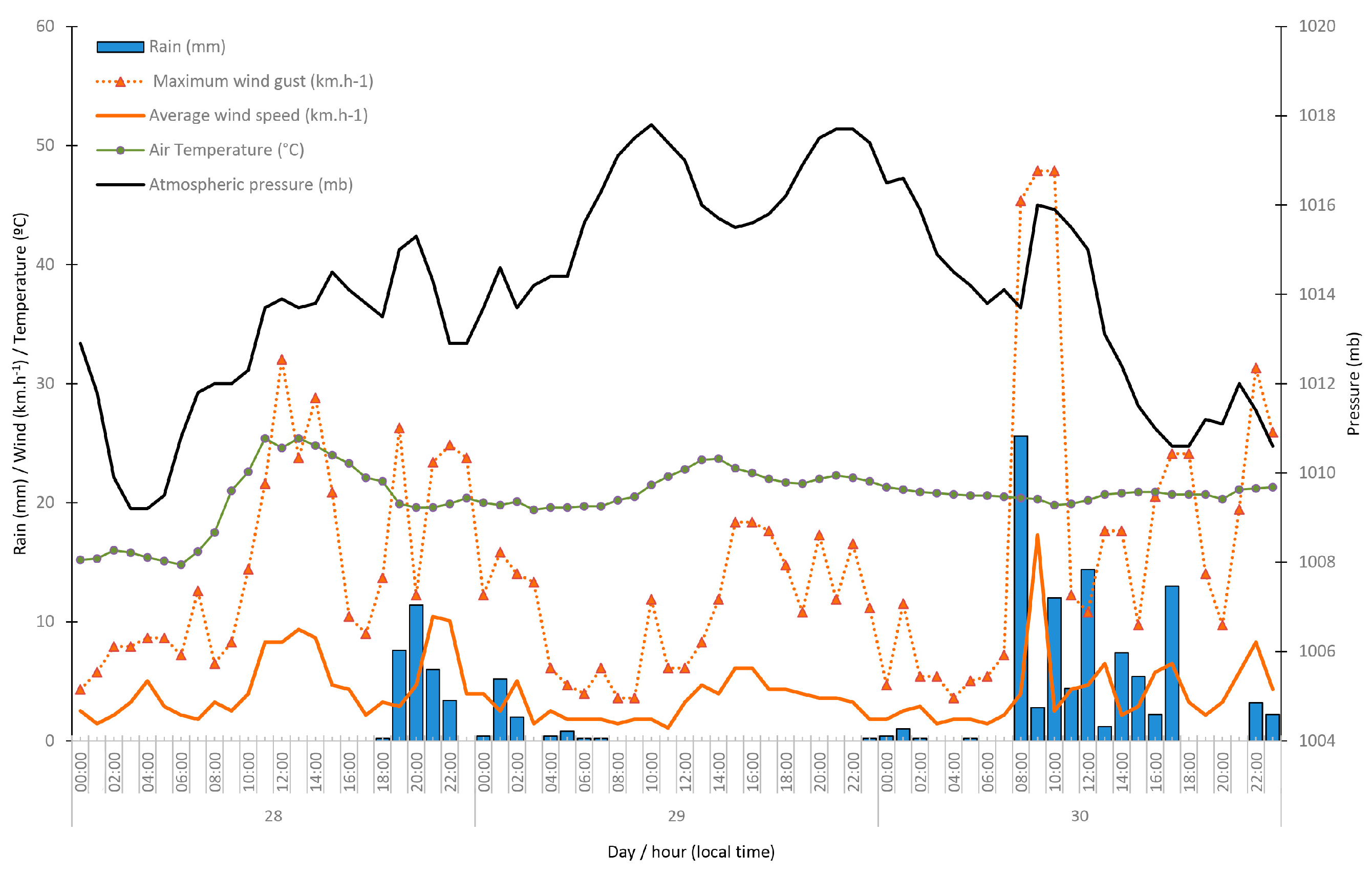
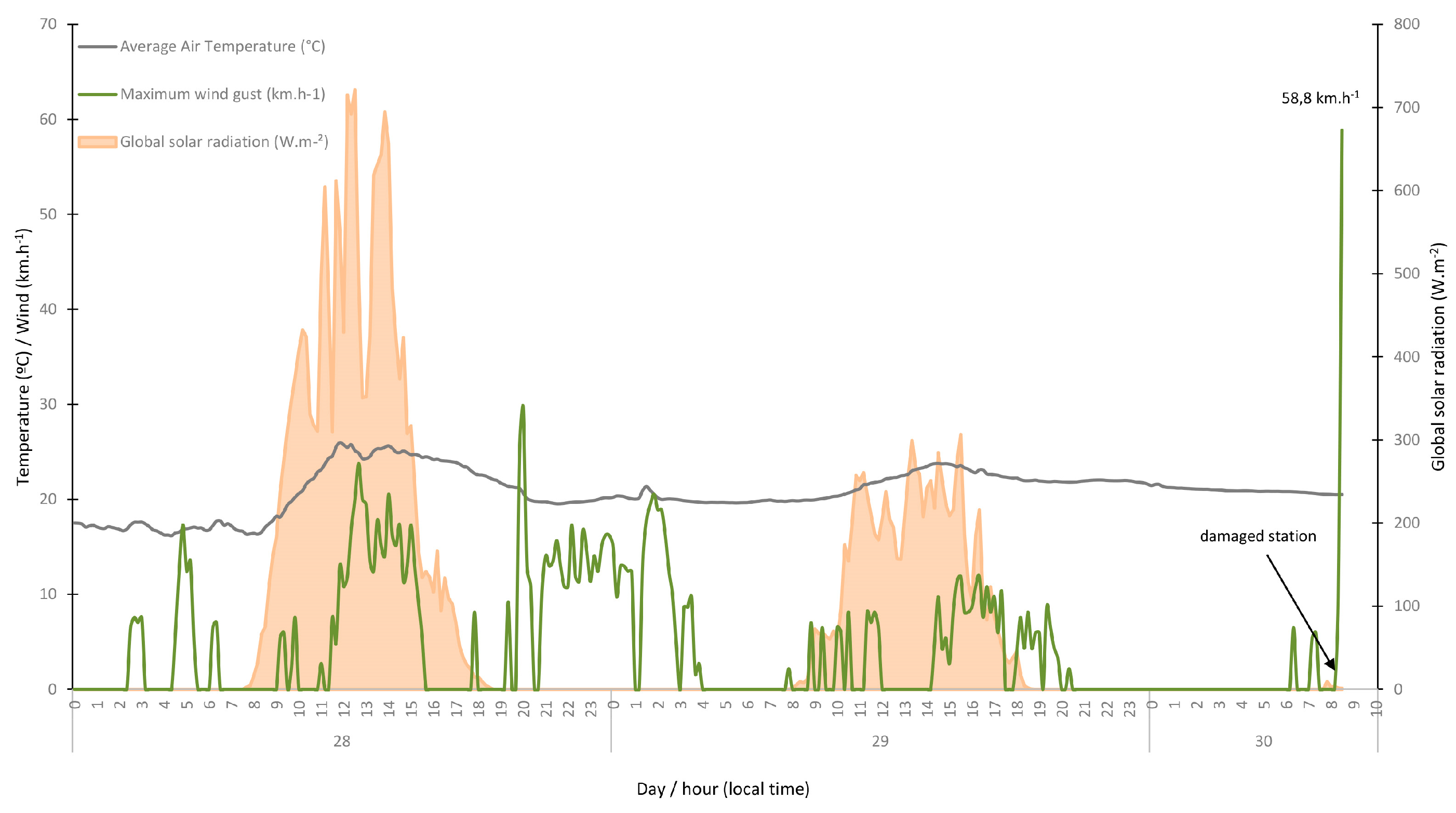

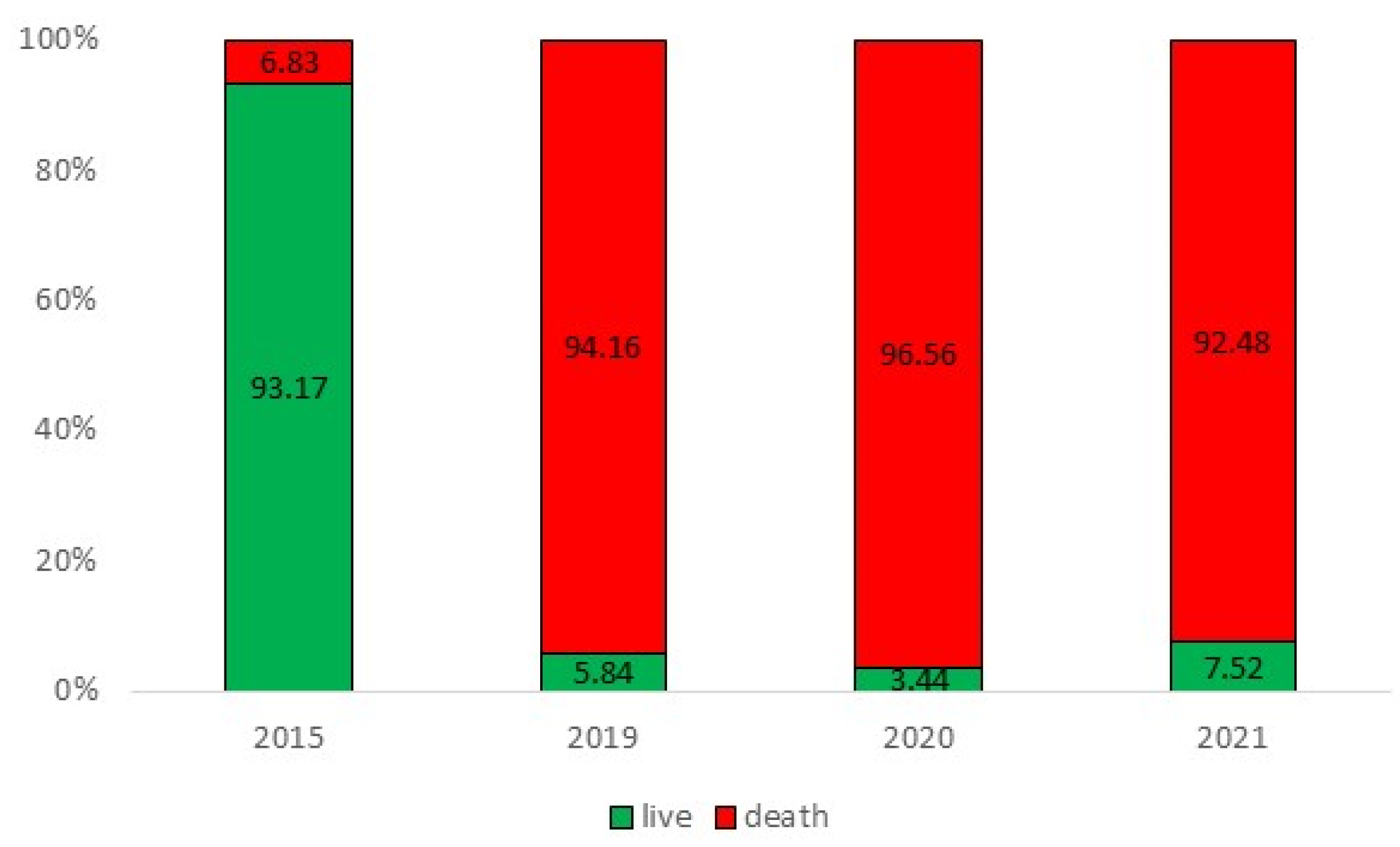

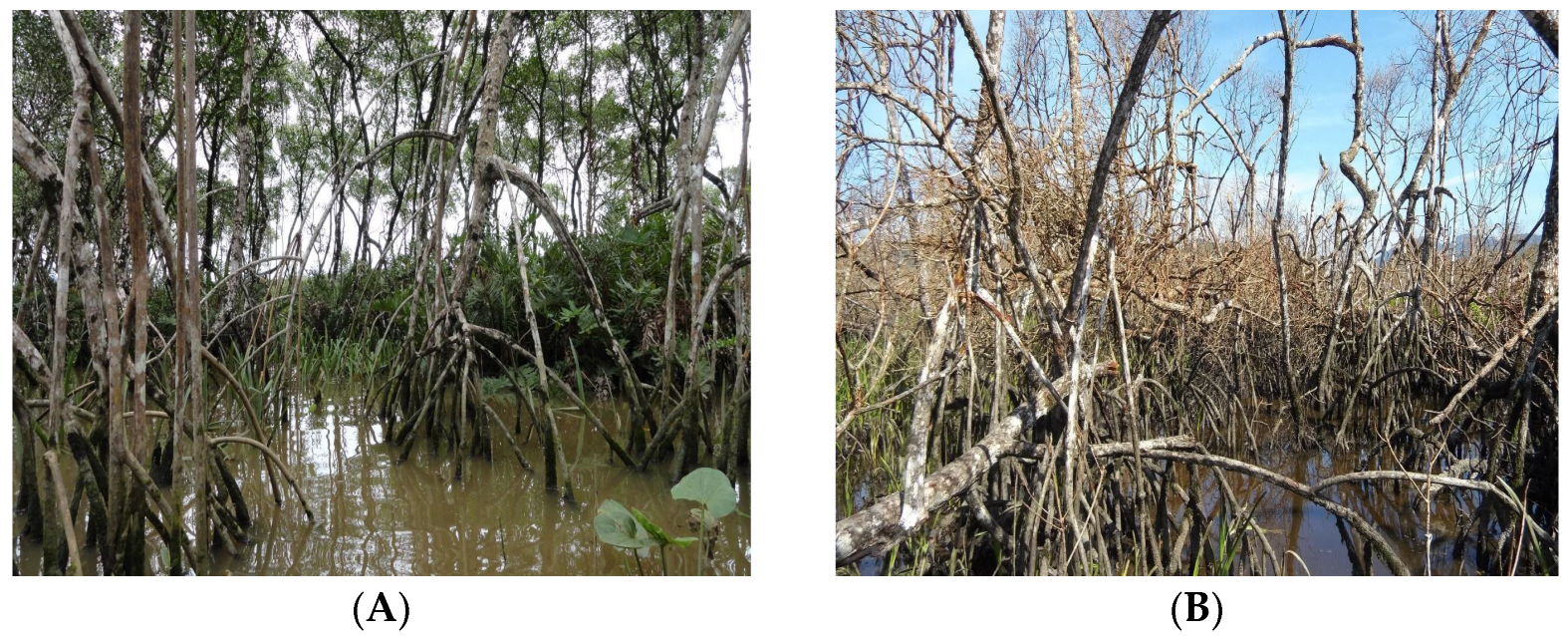

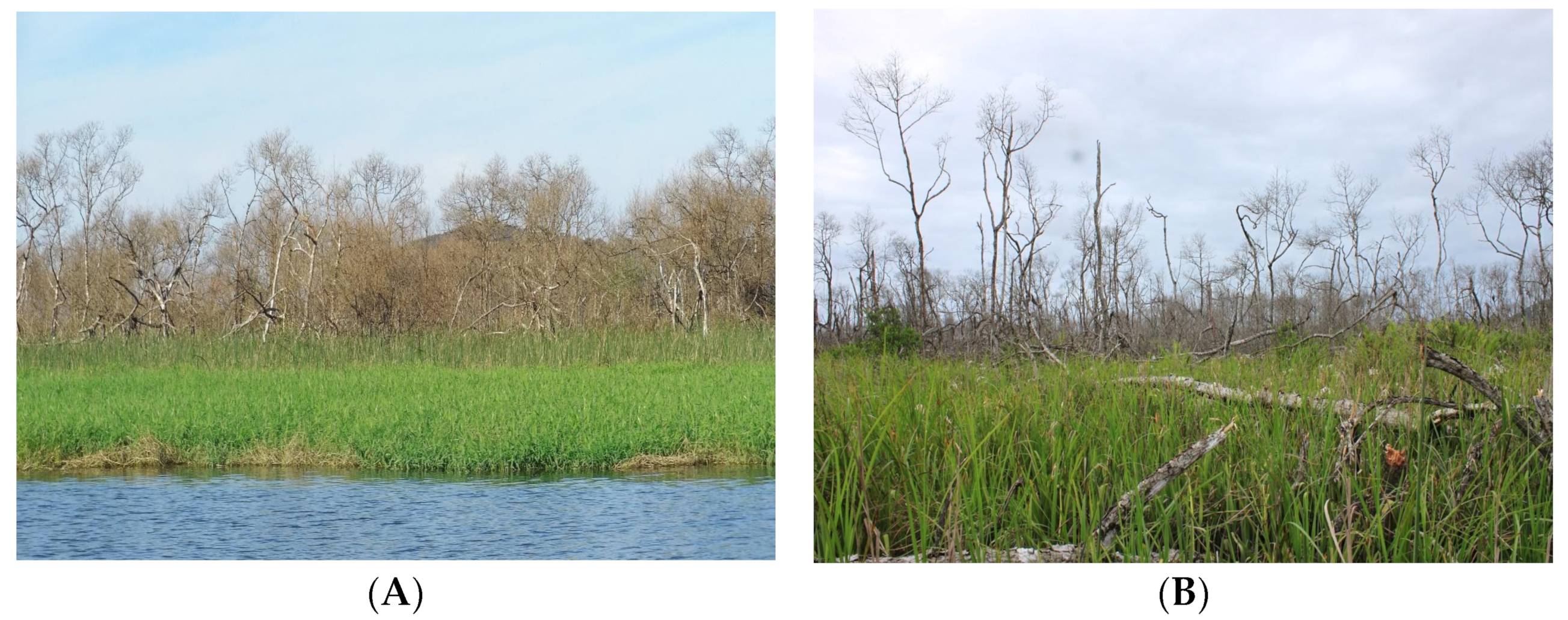


| Data | Class | NDVI/OSAVI | LAI |
|---|---|---|---|
| 25 May 2019 | Mangrove | 0.72 | 4.25 |
| Forest | 0.77 | 4.25 | |
| Water | −0.35 | −0.62 | |
| 14 June 2019 | Mangrove | 0.35 | 0.63 |
| Forest | 0.70 | 3.56 | |
| Water | −0.35 | −0.62 | |
| 18 June 2020 | Mangrove | 0.40 | 0.91 |
| Forest | 0.73 | 4.61 |
| NDVI/OSAVI Class | Area (ha) 25 May 2019 | Area (ha) 14 June 2019 | Area (ha) Difference 25 May–14 June 2019 | Area (ha) 18 June 2020 |
|---|---|---|---|---|
| <0.0 | 1.282 | 1.291 | 9 | 1.271 |
| 0.0–0.2 | 116 | 131 | 15 | 157 |
| 0.2–0.4 | 144 | 368 | 224 | 307 |
| 0.4–0.6 | 310 | 953 | 643 | 544 |
| 0.6–0.8 | 5.614 | 5.110 | −504 | 5.509 |
| 0.8–1.0 | 390 | 5 | −385 | 70 |
| LAI Class | Area (ha) 25 May 2019 | Area (ha) 14 June 2019 | Area (ha) Difference | Area (ha) 18 June 2020 |
|---|---|---|---|---|
| >0.0 | 1.342 | 1.359 | 17 | 1.365 |
| 0.0–0.5 | 128 | 215 | 87 | 202 |
| 0.5–1.0 | 140 | 400 | 260 | 294 |
| 1.0–1.5 | 134 | 355 | 221 | 220 |
| 1.5–2.0 | 100 | 372 | 272 | 182 |
| 2.0–2.5 | 82 | 371 | 289 | 155 |
| 2.5–3.0 | 70 | 314 | 244 | 139 |
| >3.0 | 5.562 | 4.473 | −1.089 | 5.300 |
| Level | Condition |
|---|---|
| None or partial | Less than 25% leaf loss |
| Major | 25–50% defoliation, some loss of branches, and scattered fallen trees |
| Severe | More than 75% defoliation, some fallen trees |
| Total | More than 50% of trees down |
| Catastrophic | More than 75% of trees fallen or broken |
Disclaimer/Publisher’s Note: The statements, opinions and data contained in all publications are solely those of the individual author(s) and contributor(s) and not of MDPI and/or the editor(s). MDPI and/or the editor(s) disclaim responsibility for any injury to people or property resulting from any ideas, methods, instructions or products referred to in the content. |
© 2023 by the authors. Licensee MDPI, Basel, Switzerland. This article is an open access article distributed under the terms and conditions of the Creative Commons Attribution (CC BY) license (https://creativecommons.org/licenses/by/4.0/).
Share and Cite
Lima, N.; Cunha-Lignon, M.; Martins, A.; Armani, G.; Galvani, E. Impacts of Extreme Weather Event in Southeast Brazilian Mangrove Forest. Atmosphere 2023, 14, 1195. https://doi.org/10.3390/atmos14081195
Lima N, Cunha-Lignon M, Martins A, Armani G, Galvani E. Impacts of Extreme Weather Event in Southeast Brazilian Mangrove Forest. Atmosphere. 2023; 14(8):1195. https://doi.org/10.3390/atmos14081195
Chicago/Turabian StyleLima, Nádia, Marília Cunha-Lignon, Alécio Martins, Gustavo Armani, and Emerson Galvani. 2023. "Impacts of Extreme Weather Event in Southeast Brazilian Mangrove Forest" Atmosphere 14, no. 8: 1195. https://doi.org/10.3390/atmos14081195
APA StyleLima, N., Cunha-Lignon, M., Martins, A., Armani, G., & Galvani, E. (2023). Impacts of Extreme Weather Event in Southeast Brazilian Mangrove Forest. Atmosphere, 14(8), 1195. https://doi.org/10.3390/atmos14081195









